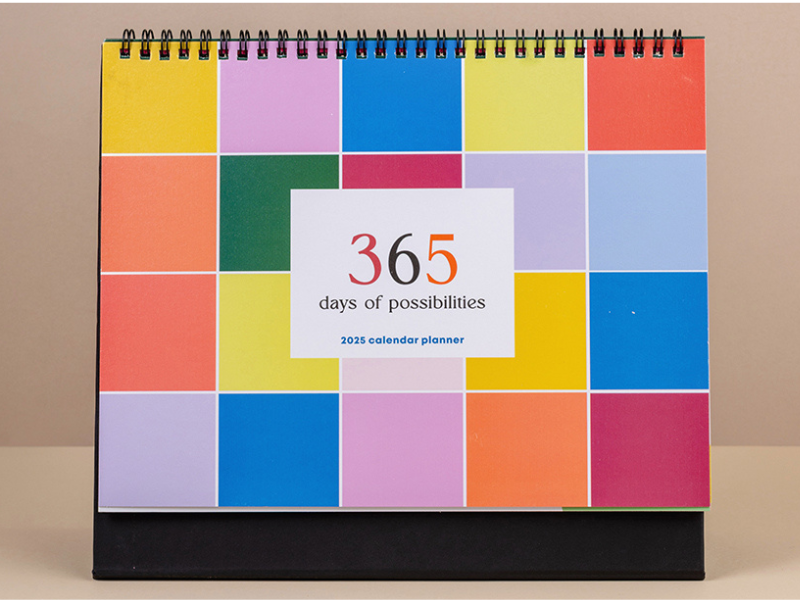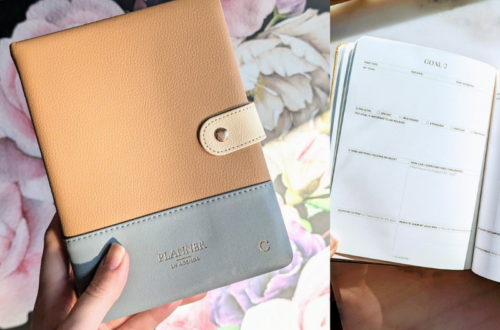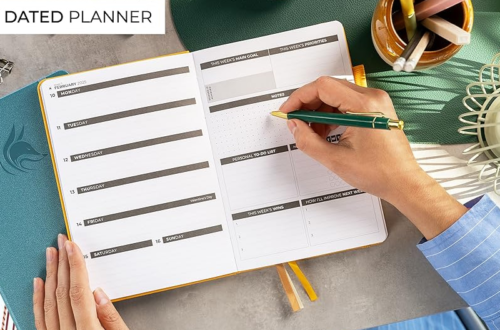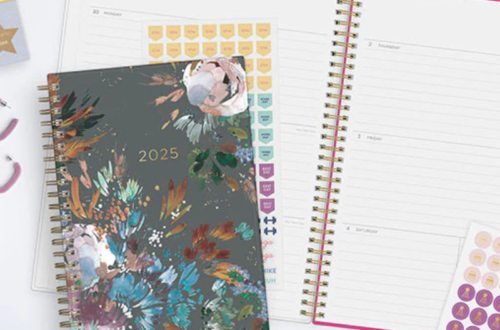As the new year approaches, it’s time to take charge of 2025 with a fresh perspective, creative energy, and a plan that’ll help you reach your goals. A yearly planner is not just about tracking appointments and deadlines—it’s an essential tool to help you prioritize, stay organized, and stay inspired throughout the year. If you’re looking to make 2025 your most productive and fulfilling year yet, you’re in the right place.
In this post, we’ll dive into 10 creative ways to plan your 2025 with a yearly planner. These innovative strategies will ensure that your planner becomes more than just a book of dates; it’ll be a powerful tool for achieving your dreams, maintaining balance, and fostering personal growth. Let’s get started!
Set Yearly Goals with a Purpose-Driven Vision Board
Your planner is the perfect place to create a vision board that reflects your personal and professional aspirations for 2025. While a vision board is typically seen as something visual—cutting out pictures and sticking them to a poster—why not transform that concept into a section in your planner?
How to do it:
- Visualize Your Year: Start by listing your big goals for 2025 in areas like career, relationships, health, and personal growth. These are the areas where you want to focus your energy.
- Use a Dedicated Page: Many planners offer extra pages or blank sections. Dedicate one of these to your vision board. You can use stickers, photos, or even sketches to symbolize your goals and dreams.
- Break It Down: For each large goal, break it into actionable steps. You can assign these tasks throughout the year, so it doesn’t just remain a broad idea but becomes something you actively work on.
By creating a vision board within your planner, you’ll have it within reach every day, making your dreams feel tangible and achievable.
Monthly Focus Areas to Stay on Track
A great way to structure your year is by focusing on one specific area of your life each month. This can help you break down large goals into manageable chunks and create a well-rounded approach to your year.
How to do it:
- Choose Monthly Themes: Assign each month a focus area. For example, January could be dedicated to health and fitness, while February might focus on personal development or career growth.
- Set Specific Goals: Within each month, set specific goals related to the theme. For health, this could be trying new workouts or establishing a consistent routine. For personal growth, it might involve reading a self-improvement book or attending a workshop.
- Review Your Progress: At the end of each month, take some time to reflect on what you accomplished and how the focus area influenced your overall growth.
This monthly breakdown ensures that you give attention to different aspects of your life, leading to holistic improvement by the end of the year.
Use a Daily Gratitude Journal for Mindfulness
A planner isn’t just for keeping track of tasks; it’s also a fantastic place to incorporate mindfulness. Start each day with a gratitude practice, using your planner to reflect on the positive aspects of your life.
How to do it:
- Daily Gratitude Prompts: Dedicate a section of your planner to daily gratitude. Each morning, write down three things you’re grateful for. It could be something as simple as a great cup of coffee, a kind word from a friend, or a work achievement.
- End-of-Day Reflection: At night, write down something that made you smile or something you accomplished. This practice will help you stay focused on the positives in your life, which in turn can boost your mood and productivity.
- Weekly Review: Every week, review your gratitude entries and reflect on the positive momentum you’ve built. This can help you stay grounded and motivated for the days ahead.
This gratitude practice will not only inspire you daily but also allow you to track your journey toward positivity throughout the year.
Track Your Habits to Cultivate Consistency
Building good habits takes time and dedication, but a planner can serve as a powerful tool to keep you on track. Whether you’re trying to establish a morning routine, exercise regularly, or practice mindfulness, tracking your habits in a yearly planner will help you stay accountable and see your progress over time.
How to do it:
- Habit Tracker: Many planners come with built-in habit trackers. If yours doesn’t, you can easily create one yourself. Make a grid where each row represents a habit you want to track, and each column represents a day of the month.
- Start Small: Choose 2-3 habits to focus on per month, so you don’t overwhelm yourself. For example, if you want to focus on drinking more water, write down how much water you drink each day.
- Celebrate Wins: Whenever you complete a habit for the day, check it off. Celebrate those small wins! At the end of the month, look at the streaks you’ve created and feel accomplished.
Tracking your habits will provide you with valuable insights into your consistency, and before you know it, those positive habits will become second nature.
Create a Financial Plan for the Year
Money management is essential to achieving your life goals, and your planner can help you maintain a budget, track your spending, and save for big events or projects in 2025. A financial plan ensures you’re on top of your finances and can handle any unexpected expenses.
How to do it:
- Monthly Budgeting: Each month, write down your income, expected expenses, and savings goals. At the end of the month, review your spending and make adjustments where necessary.
- Set Financial Milestones: Perhaps you want to save for a vacation or pay off credit card debt. Set clear, measurable goals, and break them into actionable steps.
- Expense Tracking: Create a section in your planner to track all your daily or weekly expenses. This allows you to stay aware of where your money is going and make more conscious decisions.
A financial plan in your planner will give you control over your finances and help you stay on track toward your financial goals.
Use Color-Coding for Effective Time Management
Color-coding is a simple but effective way to visually organize your tasks and appointments in your planner. By assigning specific colors to different categories (work, personal, health, etc.), you can quickly spot what’s most important and stay on top of your schedule.
How to do it:
- Assign Colors: Choose a color for each category of your life. For example, blue could represent work tasks, green for health-related activities, and yellow for personal events.
- Use Stickers or Markers: Incorporate fun and colorful stickers or markers to add personality to your planner and make it easier to differentiate between your commitments.
- Review Your Calendar: At a glance, you’ll be able to see if you’re overloading yourself in one area (e.g., too many work meetings) or if you’re neglecting another (e.g., self-care or exercise).
Color-coding will make your planner visually appealing and organized, allowing you to stay on top of your time management effortlessly.
Incorporate a Meal Planning Section for Healthier Living
One way to stay organized in 2025 and improve your health is by planning your meals in advance. Using your planner to organize weekly or monthly meal plans will save you time, reduce stress, and ensure you’re eating nutritious, balanced meals.
How to do it:
- Weekly Meal Plan: Every Sunday, take a few minutes to plan your meals for the upcoming week. Write down your breakfast, lunch, dinner, and snacks.
- Grocery List: Based on your meal plan, create a grocery list of the ingredients you’ll need. This helps reduce impulse buys and ensures you have everything you need to cook healthy meals.
- Track Your Nutrition: You can also use your planner to track your calories, water intake, or any special dietary goals you have, like increasing protein or cutting back on sugar.
Meal planning with your planner is an excellent way to streamline your health goals and make eating well a consistent part of your routine.
Create a Bucket List for Adventure and Fun
Life is meant to be lived, so why not make 2025 the year you tick off items from your bucket list? Your planner is a great place to track the adventures you want to experience, from traveling to new places to trying out new hobbies.
How to do it:
- List Your Dreams: Write down the experiences you want to have in 2025—big or small. This could include traveling to a specific country, taking a cooking class, or even something like running a marathon.
- Break it Down: Make the bucket list actionable by setting timelines for each item. When will you book that vacation? When will you register for that class? Use your planner to break these big dreams into manageable goals.
- Celebrate Your Wins: As you accomplish each item on your bucket list, write it down in your planner as a celebration of your journey.
Your planner is your personal adventure map, guiding you toward a year full of exciting, meaningful experiences.
Monthly Reflection and Planning Sessions
Sometimes, life moves so fast that it’s easy to forget to slow down and reflect. Setting aside time for a monthly review in your planner helps you assess how things are going, celebrate successes, and recalibrate for the next month.
How to do it:
- Set a Monthly Reflection Ritual: At the end of each month, take an hour to look back at your goals and achievements. What did you accomplish? What challenges did you face? How did you overcome them?
- Adjust Goals: Based on your reflection, adjust your goals for the upcoming month. If something didn’t work out as planned, reframe it and come up with a new approach.
- Plan for the Next Month: After your reflection, plan for the upcoming month. Write down what you want to achieve and how you’ll make it happen.
This monthly practice will ensure you’re always improving and staying aligned with your vision for 2025.
Incorporate Self-Care and Downtime into Your Schedule
It’s easy to get caught up in the hustle of work, family, and personal goals, but it’s crucial to take time for yourself. Your planner should remind you to take care of your mental, emotional, and physical well-being throughout the year.
How to do it:
- Schedule Downtime: Block out time in your planner each week for self-care activities like reading, relaxing, meditating, or even taking a bath.
- Weekly Reflection: Use a section of your planner for weekly self-care check-ins. How are you feeling? Are you taking enough time for yourself?
- Prioritize Rest: Don’t just schedule work and errands; make sure you’re prioritizing rest and rejuvenation too. Your productivity will improve when you feel balanced and energized.
By incorporating self-care into your planner, you’ll ensure that you stay healthy, happy, and motivated throughout the year.
With the right mindset and planning tools, 2025 can be your most organized and fulfilling year yet. By using a yearly planner in creative and intentional ways, you’ll not only stay on top of your tasks and appointments but also cultivate personal growth, stay inspired, and make your dreams a reality. Whether you’re tracking your habits, planning your meals, or reflecting on your journey, your planner will be the compass guiding you toward a year of success, adventure, and joy.
So, grab your 2025 planner and get ready to make this year your most epic one yet!






